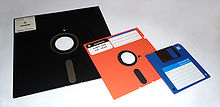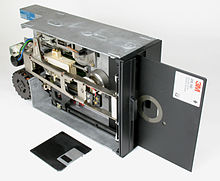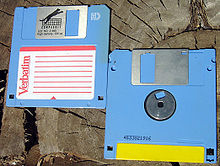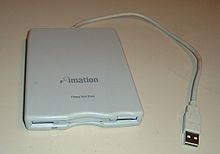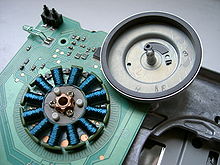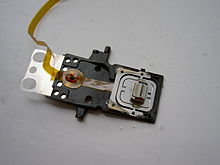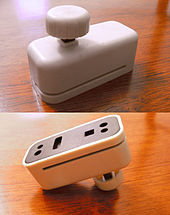- Floppy disk
-
"Floppy" redirects here. For other uses, see Floppy (disambiguation).
A floppy disk is a disk storage medium composed of a disk of thin and flexible magnetic storage medium, sealed in a rectangular plastic carrier lined with fabric that removes dust particles. They are read and written by a floppy disk drive (FDD).
Floppy disks, initially as 8-inch (200 mm) media and later in 5.25-inch (133 mm) and 3.5-inch (89 mm) sizes, were a ubiquitous form of data storage and exchange from the mid-1970s well into the first decade of the 21st century.[1]
By 2010, computer motherboards were rarely manufactured with floppy drive support; 3 1⁄2" floppies could be used with an external USB drive, but 5 1⁄4", 8", and non-standard drives could only be handled by old equipment.
While floppy disk drives still have some limited uses, especially with legacy industrial computer equipment, they have been superseded by data storage methods with much greater capacity, such as USB flash drives, portable external hard disk drives, optical discs, memory cards, and computer networks.
Contents
History
The earliest floppy disks, developed in the late 1960s, were 8 inches (200 mm) in diameter;[1] they became commercially available in 1971.[2] These disks and associated drives were produced and improved upon by IBM and other companies such as Memorex, Shugart Associates, and Burroughs Corporation.[3] The term "floppy disk" appeared in print as early as 1970,[4] and although in 1973 IBM announced its first media as "Type 1 Diskette" the industry continued to use the terms "floppy disk" or "floppy".
In 1976, Shugart Associates introduced the first 5 1⁄4-inch FDD. By 1978 there were more than 10 manufacturers producing such FDDs. There were competing floppy disk formats, with hard and soft sector versions and encoding schemes such as FM, MFM and GCR. The 5 1/4 inch format displaced the 8-inch one for most applications, and the hard sectored disk format disappeared. In 1984, IBM introduced the 1.2 MB dual sided floppy disk along with its AT model. IBM started using the 720 kB double density 3.5" microfloppy disk on its Convertible laptop computer and the 1.44 MB high density version with the PS/2 line in 1986. These disk drives could be added to older PC models. In 1988 IBM introduced a drive for 2.88 MB "DSED" diskettes in its top-of-the-line PS/2 models but this was a commercial failure.
Throughout the early 1980s, limitations of the 5 1⁄4-inch format became clear. Originally designed to be more practical than the 8-inch format, it was itself too large; as the quality of recording media grew, data could be stored in a smaller area.[citation needed] A number of solutions were developed, with drives at 2, 2 1⁄2, 3 and 3 1⁄2 inches (and Sony's 90.0 mm × 94.0 mm disk) offered by various companies.[citation needed] They all shared a number of advantages over the old format, including a rigid case with a sliding write protection tab, protecting them from damage; the large market share of the 5 1⁄4-inch format made it difficult for these new formats to gain significant market share.[citation needed] A variant on the Sony design, introduced in 1982 by a large number of manufacturers, was then rapidly adopted; by 1988 the 3 1⁄2-inch was outselling the 5 1⁄4-inch.[5]
By the end of the 1980s, the 5 1⁄4-inch disks had been superseded by the 3 1⁄2-inch disks. By the mid-1990s, the 5 1⁄4-inch drives had virtually disappeared as the 3 1⁄2-inch disk became the predominant floppy disk. The advantages of the 3 1⁄2-inch disk were its smaller size and its plastic case which provided better protection from dirt and other environmental risks.
Ubiquity
Floppy disks became ubiquitous in the 1980s and 1990s in their use with personal computers and home computers to distribute software, transfer data, and create backups. Before hard disks became affordable, floppy disks were often used to store a computer's operating system (OS). Most home computers had a primary OS and BASIC stored as ROM, with the option of loading a more advanced disk operating system from a floppy disk. By the early 1990s, the increasing software size meant large packages like Windows or Adobe Photoshop required a dozen disks or more. In 1996, there were an estimated five billion floppy disks in use.[6] Then, distribution of larger packages was gradually replaced by CD-ROM and online distribution (for smaller programs). An attempt to continue the floppy disk was the SuperDisk in the late 1990s, with a capacity of 120 MB[7] and backward compatible with standard 3 1⁄2-inch floppies. External USB-based floppy disk drives are available; many modern systems provide firmware support for booting from such a drive.
Decline
Mechanically incompatible higher-density disks were introduced, like the Iomega Zip disk. Adoption was limited by the competition between proprietary formats and the need to buy expensive drives for computers where the disks would be used. In some cases, failure in market penetration was exacerbated by release of higher-capacity versions of the drive and media not backward compatible with the original drives, dividing the users between new and old adopters. A chicken or the egg scenario ensued, with consumers wary of making costly investments into unproven and rapidly changing technologies, resulting in none of the technologies being able to prove themselves and stabilize their market presence. Recordable CDs with even greater capacity, compatible with existing infrastructure of CD-ROM drives, made the new floppy technologies redundant, their lack of reusability negated by their extremely low cost and countered by re-writeable CDs. Networking, advancements in flash-based devices and widespread adoption of USB provided another alternative that made optical storage obsolete for some purposes. The rise of file sharing and multi-megapixel digital photography encouraged the use of files larger than most 3 1⁄2-inch disks could hold. Floppy disks were commonly used as sneakernet carriers for file transfer, but the broad availability of LANs and fast Internet connections provided a simpler and faster method of transferring such files. Other removable storage devices have advantages in both capacity and performance when network connections are unavailable or when networks are inadequate.
In 1991, Commodore introduced the CDTV, with a CD-ROM drive in place of the floppy drive. The kickstart of AmigaOS was stored in ROM as in other Amigas, making CDTV still booting from floppy rather than from CD-ROM, like other Amigas. Apple introduced the iMac in 1998 with a CD-ROM drive but no floppy drive; this made USB-connected floppy drives popular accessories as the iMac came without any writeable removable media device. This transition from standard floppies was relatively easy for Apple, since all Macintosh models originally designed to use a CD-ROM drive could boot and install their operating system from CD-ROM early on. PC manufacturers were initially reluctant to remove the floppy drive because many IT departments appreciated the Sneakernet built-in file-transfer mechanism that always worked and required no device driver to operate properly. Then, manufacturers and retailers progressively reduced the availability floppy drives and disks; widespread support for USB flash drives and BIOS boot support helped them. In February 2003, Dell announced floppy drives would no longer be pre-installed on Dell Dimension home computers, although still available as a selectable option and purchasable as an aftermarket OEM add-on.[8] On 29 January 2007, PC World stated that only 2% of the computers they sold contained built-in floppy disk drives; once present stocks were exhausted, no more standard floppies would be sold.[9] In 2009, Hewlett-Packard stopped supplying standard floppy drives on business desktops.[citation needed]
Use in the early 21st century
Floppy disks are used for emergency boots in aging systems lacking support for other bootable media, and for BIOS updates since most BIOS and firmware programs can still be executed from bootable floppy disks. If BIOS updates fail or become corrupt, floppy drives can sometimes be used to perform a recovery. The music and theatre industries still use equipment requiring standard floppy disks (e.g. synthesizers, samplers, drum machines, sequencers, and lighting consoles). Industrial automation equipment such as programmable machinery and industrial robots may not have a USB interface; data and programs are then loaded from disks, damageable in industrial environments. This may not be replaced due to cost or requirement for continuous availability; existing software emulation and virtualization do not solve this problem because no operating system is present or a customized operating system is used that has no drivers for USB devices. Hardware floppy disk emulators can be made to interface floppy disk controllers to a USB port that for flash drives; several manufacturers make such emulators.
Some outdated systems still require floppy disks to operate; for instance, tax authorities and the Pension Fund of Russia, as of 2011, still accept or even require electronic reports to be submitted on floppy disks.[citation needed]
For more than two decades, the floppy disk was the primary external writable storage device used. Most computing environments before the 1990s were non-networked and floppy disks were the primary means of transferring data between computers, a method known informally as sneakernet. Unlike hard disks, floppy disks are handled and seen; even a novice user can identify a floppy disk. Because of these factors, a picture of a 3 1⁄2" floppy disk has become a metaphor for saving data. The floppy disk symbol is still used by software on user interface elements related to saving files, such as the release of Microsoft Office 2010, even though such disks are increasingly obsolete.[10]
 Screenshot of the toolbar in OpenOffice.org, highlighting the Save icon, which depicts a floppy disk
Screenshot of the toolbar in OpenOffice.org, highlighting the Save icon, which depicts a floppy disk
Design
 Internal parts of a 3 1⁄2-inch floppy disk. 1) A hole that indicates a high-capacity disk. 2) The hub that engages with the drive motor. 3) A shutter that protects the surface when removed from the drive. 4) The plastic housing. 5) A polyester sheet reducing friction against the disk media as it rotates within the housing. 6) The magnetic coated plastic disk. 7) A schematic representation of one sector of data on the disk; the tracks and sectors are not visible on actual disks.
Internal parts of a 3 1⁄2-inch floppy disk. 1) A hole that indicates a high-capacity disk. 2) The hub that engages with the drive motor. 3) A shutter that protects the surface when removed from the drive. 4) The plastic housing. 5) A polyester sheet reducing friction against the disk media as it rotates within the housing. 6) The magnetic coated plastic disk. 7) A schematic representation of one sector of data on the disk; the tracks and sectors are not visible on actual disks.
Structure
The 5 1⁄4-inch disk has a large circular hole in the center for the drive's spindle and a small oval aperture in both sides of the plastic to allow the drive's heads to read and write data; the magnetic medium can be spun by rotating it from the middle hole. A small notch on the right of the disk identifies that it is writable, detected by a mechanical switch or phototransistor above it; if it is not present, the disk is read-only. Punch devices were sold to convert read-only disks to writable ones and enable writing on the unused side of single sided disks; such modified disks became known as flippy disks. Tape may be used over the notch to protect writable disks from unwanted writing. Oddly: this arrangement was the converse of the system used on 8 inch floppy discs where the notch had to be covered before the disc could be written to.
Another LED/photo-transistor pair located near the center of the disk detects the index hole once per rotation in the magnetic disk; it is used to detect the angular start of each track and whether or not the disk is rotating at the correct speed. Early 8-inch and 5 1⁄4-inch disks had physical holes for each sector and were termed hard sectored disks. Later soft sectored disks had only one index hole, and sector position was determined by the disk controller or low level software from patterns marking the start of a sector. Generally, the same drives were used to read and write both types of disks, with only the disks and disk controllers differing. Some operating systems utilizing soft sectors, such as Apple DOS, did not use the index hole; the drives designed for such systems often lacked the corresponding sensor; this was mainly a hardware cost saving measure.
Inside the disk are two layers of fabric, with the medium sandwiched in the middle. The fabric is designed to reduce friction between the medium and the outer casing, and catch particles of debris abraded off the disk to keep them from accumulating on the heads. The outer casing is usually a one-part sheet, double-folded with flaps glued or spot-welded together. The 8-inch disk had read-only logic that was the reverse of the 5 1⁄4-inch disk, with the slot on the side having to be taped over to allow writing.
The core of the 3 1⁄2-inch disk is the same as the other two disks, but the front has only a label and a small aperture for reading and writing data, protected by the slider - a spring-loaded metal or plastic cover, pushed to the side on entry into the drive. Rather than having a hole in the center, it has a metal hub which mates to the spindle of the drive. Typical 3 1⁄2-inch disk magnetic coating materials are:[11]
- DD: 2 µm magnetic iron oxide (Coercivity approx. 300 OE Oersted)
- HD: 1.2 µm cobalt doped iron oxide (Coercivity approx. 600 OE)
- ED: 3 µm Barium ferrite (Coercivity approx. 750 OE)
Two holes at the bottom left and right indicate whether the disk is write-protected and whether it is high-density; these holes are spaced as far apart as the holes in punched A4 paper, allowing write-protected high-density floppies to be clipped into standard ring binders. A notch at top right ensures that the disk is in the correct orientation and an arrow at top left indicating direction of insertion. The drive usually has a button that when pressed ejects the disk with varying degrees of force, the discrepancy due to the ejection force provided by the spring of the slider cover. In IBM PC compatibles, a floppy disk may be inserted or ejected manually at any time. The drive has a 'change switch' that detects when a disc is ejected or inserted. Failure of this mechanical switch is a common source of disc corruption if a disc is changed and the drive (and hence the operating system) fails to notice.
One of the chief usability problems of the floppy disk is its vulnerability; even inside a closed plastic housing, the disk medium is highly sensitive to dust, condensation and temperature extremes. As with all magnetic storage, it is vulnerable to magnetic fields. Blank disks have been distributed with an extensive set of warnings, cautioning the user not to expose it to dangerous conditions. Disks must not be roughly treated or removed from the drive while the magnetic media is still spinning, since doing so is likely to cause damage to the disk, drive head, or stored data. On the other hand, the 3 1⁄2-inch floppy has been lauded for its mechanical usability by HCI expert Donald Norman:[12]
"A simple example of a good design is the 3½-inch magnetic diskette for computers, a small circle of "floppy" magnetic material encased in hard plastic. Earlier types of floppy disks did not have this plastic case, which protects the magnetic material from abuse and damage. A sliding metal cover protects the delicate magnetic surface when the diskette is not in use and automatically opens when the diskette is inserted into the computer. The diskette has a square shape: there are apparently eight possible ways to insert it into the machine, only one of which is correct. What happens if I do it wrong? I try inserting the disk sideways. Ah, the designer thought of that. A little study shows that the case really isn't square: it's rectangular, so you can't insert a longer side. I try backward. The diskette goes in only part of the way. Small protrusions, indentations, and cutouts, prevent the diskette from being inserted backward or upside down: of the eight ways one might try to insert the diskette, only one is correct, and only that one will fit. An excellent design."Operation
A spindle motor in the drive rotates the magnetic medium at a certain speed, while a stepper motor-operated mechanism moves the magnetic read/write head(s) along the surface of the disk. Both read and write operations require the media to be rotating and the head to contact the disk media, an action accomplished by a "disk load" solenoid.[13] To write data, current is sent through a coil in the head as the media rotates. The head's magnetic field aligns the magnetic particles directly below the head on the media. When the current is reversed the particles align in the opposite direction encoding the data digitally. To read data, the magnetic particles in the media induce a tiny voltage in the head coil as they pass under it. This small signal is amplified and sent to the floppy disk controller, which converts the streams of pulses from the media into data, checks it for errors, and sends it to the host computer system.
A blank "unformatted" diskette has a coating of magnetic oxide with no magnetic order to the particles. During formatting, the particles are aligned forming a pattern of magnetized tracks, each broken up into sectors, enabling the controller to properly read and write data. The tracks are concentric rings around the center, with spaces between tracks where no data is written; gaps with padding bytes are provided between the sectors and at the end of the track to allow for slight speed variations in the disk drive, and to permit better interoperability with disk drives connected to other similar systems. Each sector of data has a header that identifies the sector location on the disk. A cyclic redundancy check (CRC) is written into the sector headers and at the end of the user data so that the disk controller can detect potential errors. Some errors are soft and can be resolved by automatically re-trying the read operation; other errors are permanent and the disk controller will signal a failure to the operating system if multiple attempts to read the data still fail.
After a disk is inserted, a catch or lever at the front of the drive is manually lowered to prevent the disk from accidentally emerging, engage the spindle clamping hub, and in two-sided drives, engage the second read/write head with the media. In some 5 1⁄4-inch drives, insertion of the disk compresses and locks an ejection spring which partially ejects the disk upon opening the catch or lever. This enables a smaller concave area for the thumb and fingers to grasp the disk during removal. Newer 5 1⁄4-inch drives and all 3 1⁄2-inch drives automatically engage the spindle and heads when a disk is inserted, doing the opposite with the press of the eject button. On Apple Macintosh computers with built-in floppy drives, the ejection button is replaced by software controlling an eject motor which only does so when the operating system no longer needs to access the drive. The user could drag the image of the floppy drive to the trash can on the desktop to eject the disk. The first such drives were the slim "Twiggy" drives of the late Apple Lisa. In the case of a power failure or drive malfunction, a loaded disk can removed manually by inserting a straightened paper clip into a small hole at the drive's front panel, forcing the disk to eject manually. External 3 1⁄2-inch drives from Apple were equipped with eject buttons; the button was ignored when the drive was plugged into a Mac, but not if the drive was used with an Apple II, as ProDOS did not support software-controlled ejection. Some other computer designs, such as the Commodore Amiga, monitor for a new disk continuously and have button ejection mechanisms.
Formats
Most common floppy disks in use are formatted in the FAT12 file system format, though sometimes disks may use a more exotic file system and/or be superformatted to accommodate slightly more data. Some floppy-based Linux distributions utilize such techniques.[citation needed] The capacity numbers given in this section assume FAT12 formatting unless otherwise noted.
Different sizes of floppy disks are fundamentally incompatible, and disks can fit only one size of drive. Drives with 3 1⁄2-inch and 5¼-inch slots were available during the transition period between the sizes, but they contained two separate drive mechanisms. In addition, there are many subtle, usually software-driven incompatibilities between the two. 5 1⁄4-inch disks formatted for use with Apple II computers would be unreadable and treated as unformatted on a Commodore. As computer platforms began to form, attempts were made at interchangeability. For example, the "Superdrive" included from the Macintosh SE to the Power Macintosh G3 could read, write and format IBM PC-format 3½-inch disks, but few IBM-compatible computers had drives that did the reverse. 8-inch, 5 1⁄4-inch and 3 1⁄2-inch drives were manufactured in a variety of sizes, most to fit standardized drive bays. Alongside the common disk sizes were non-classical sizes for specialized systems.
8-inch floppy disk
The first floppy disk format was 8 inches in diameter; it was superseded by the 5 1⁄4-inch size.
5 1⁄4-inch floppy disk
The head gap of an 80-track high-density (1.2 MB in the MFM format) 5 1⁄4-inch drive is shorter than that of a 40-track double-density (360 kB) drive but can format, read and write 40-track disks well provided the controller supports double stepping or has a switch to do such a process. A blank 40-track disk formatted and written on an 80-track drive can be taken to its native drive without problems, and a disk formatted on a 40-track drive can be used on an 80-track drive. Disks written on a 40-track drive and then updated on an 80 track drive become permanently unreadable on any 40-track drives due to track width incompatibility (special "very slow" programs were able to correct this), among other bad scenarios. The disks would work on both machines, with RadioShack TRS-80 Model I computers using one side and the Apple II machines the other, regardless available software which could make sense of the other format[clarification needed][citation needed]. Double-sided disks could be used in drives for single-sided disks, one side at a time, by turning them over (flippy disks); more expensive dual-head drives which could read both sides without turning over were later produced, and later became used universally. Disks sold as single-sided had a magnetic coating to the same specification, but not of guaranteed quality, on both sides so that they were symmetrical and would not warp; if a notch was cut to disable write-protection of the reverse the coating was often of sufficiently good coating to use both sides.
3 1⁄2-inch floppy disk
3 1⁄2-inch floppy disk were produced with a capacity of 720 KB, followed by what became the most common format, 1.44 MB. All disks had a rectangular hole which, if and only if obstructed, write-enabled the disk. 1.44 MB disks had another hole which identified them as being of that capacity.
In IBM-compatible PCs, the three densities of 3 1⁄2-inch floppy disks are backwards-compatible: higher density drives can read, write and format lower density media. It is physically possible to format a disk at the wrong density, although it will not work properly. Fresh disks manufactured as high density can theoretically be formatted at double density only if no information has been written on the disk in high density, or the disk has been thoroughly demagnetized with a bulk eraser, as the magnetic strength of a high density record is stronger and overrides lower density, remaining on the disk and causing problems.
Writing at different densities than disks were intended for, sometimes by altering or drilling holes, was possible but deprecated.
The holes on the right side of a 3 1⁄2-inch disk can be altered as to make some disk drives and operating systems treat the disk as one of higher or lower density, for bidirectional compatibility or economical reasons. Possible modifications include:[14][15] Some computers, e.g. the PS/2 and Acorn Archimedes, ignored these holes altogether.[16]
It is possible to make a 3 1⁄2-inch floppy disk drive be recognized by a system as a 5 1⁄4-inch 360 kB or 1200 kB drive, and to read and write disks with the same number of tracks and sectors as those disks; this had some application in data exchange with obsolete CP/M systems.[citation needed]
Non-standard formats
Main article: floppy disk variants3" discs similar in construction to 3 1⁄2" were manufactured and used for a time, particularly by Amstrad computers and word processors.
Sizes, performance and capacity
Floppy disk size is often referred to in inches, even in countries using metric and though the size is defined in metric. The ANSI specification of 3 1⁄2-inch disks is entitled in part "90 mm (3.5 in)" though 90 mm is closer to 3.54 inches.[17] Formatted capacities are generally set in terms of kilobytes and megabytes.
Historical sequence of floppy disk formats Disk format Year introduced Formatted Storage capacity Marketed capacity 8-inch: IBM 23FD (read-only) 1971 79.7 kB[18] ? 8-inch: Memorex 650 1972 179 kB[19] 1.5 megabit[19] [unformatted] 8-inch: SSSD IBM 33FD / Shugart 901
1973 237.25 kB[18][20] 3.1 Mbits unformatted 8-inch: DSSD IBM 43FD / Shugart 850
1976 500.5 kB[18] 6.2 Mbits unformatted 5 1⁄4-inch (35 track) Shugart SA 400 1976[21] 87.5 kB[22] 110 kB 8-inch DSDD IBM 53FD / Shugart 850
1977 980 kB (CP/M) - 1200 kB (MS-DOS FAT) 1.2 MB 5 1⁄4-inch DD 1978 360 or 800 kB 360 kB 5 1⁄4-inch Apple Disk II (Pre-DOS 3.3) 1978 113.75 kB (256 byte sectors, 13 sectors/track, 35 tracks) 113 kB 5 1⁄4-inch Apple Disk II (DOS 3.3) 1980 140 kB (256 byte sectors, 16 sectors/track, 35 tracks) 140 kB 3 1⁄2-inch HP single sided 1982 256×16×70 = 280 kB 264 kB 3-inch 1982[23][24] 360 kB[citation needed] 125 kB (SS/SD), 500 kB (DS/DD)[24]
3 1⁄2-inch (DD at release) 1983[25] 720 kB (400 SS, 800 DS on Macintosh, 880 DS on Amiga) 1 MB 5 1⁄4-inch QD 720 kB 720 kB 5 1⁄4-inch HD 1982[26] 1155 kB 1.2 MB 3-inch DD 1984[citation needed] 720 kB[citation needed] ? 3-inch Mitsumi Quick Disk 1985 128 to 256 kB ? 2-inch 1989 720 kB[27] ? 2 1⁄2-inch 1986[28] ? ? 5 1⁄4-inch Perpendicular 1986[28] 10 MB ? 3 1⁄2-inch HD 1987 1440 kB 1.44 MB (2.0 MB unformatted) 3 1⁄2-inch ED 1987[29] 2880 kB 2.88 MB 3 1⁄2-inch Floptical (LS) 1991 21000 kB 21 MB 3 1⁄2-inch LS-120 1996 120.375 MB 120 MB 3 1⁄2-inch LS-240 1997 240.75 MB 240 MB 3 1⁄2-inch HiFD 1998/99 150/200 MB[citation needed] 150/200 MB Abbreviations: SD = Single Density; DD = Double Density; QD = Quad Density; HD = High Density; ED = Extended Density; LS = Laser Servo; HiFD = High capacity Floppy Disk; SS = Single Sided; DS = Double Sided Formatted Storage Capacity is total size of all sectors on the disk: - For 8-inch see Table of 8-inch floppy formats IBM 8-inch formats. Spare, hidden and otherwise reserved sectors are included in this number.
- For 5 1⁄4- and 3 1⁄2-inch capacities quoted are from subsystem or system vendor statements.
Marketed Capacity is the capacity, typically unformatted, by the original media OEM vendor or in the case of IBM media, the first OEM thereafter. Other formats may get more or less capacity from the same drives and disks.
Data is generally written to floppy disks in sectors (angular blocks) and tracks (concentric rings at a constant radius). For example, the HD format of 3 1⁄2-inch floppy disks uses 512 bytes per sector, 18 sectors per track, 80 tracks per side and two sides, for a total of 1,474,560 bytes per disk.[30] Some disk controllers can vary these parameters at the user's request, increasing storage on the disk, although they may not be able to be read on machines with other controllers. For example, Microsoft applications were often distributed on 3 1⁄2-inch 1.68 MB DMF disks formatted with 21 sectors instead of 18; they could still be recognized by a standard controller. On the IBM PC, MSX and most other microcomputer platforms, disks were written using a Constant Angular Velocity (CAV) format,[29] with the disk spinning at a constant speed and the sectors hold the same amount of information on each track regardless of radial location.
This was not the most efficient way to use the disk surface with available drive electronics;[citation needed] because the sectors have constant angular size, the 512 bytes in each sector are compressed more near the disk's center. A more space-efficient technique would be to increase the number of sectors per track toward the outer edge of the disk, from 18 to 30 for instance, thereby keeping constant the amount of physical disk space used for storing each sector; an example is zone bit recording. Apple implemented this in early Macintosh computers by spinning the disk slower when the head was at the edge, while maintaining the data rate, allowing 400 kB of storage per side and an extra 160 kB on a double-sided disk.[citation needed] This higher capacity came with a disadvantage: the format used a unique drive mechanism and control circuitry, meaning that Mac disks could not be read on other computers. Apple eventually reverted to constant angular velocity on HD floppy disks with their later machines, still unique to Apple as they supported the older variable-speed formats.
Disk formatting is usually done by a utility program supplied by the computer OS manufacturer; generally, it sets up a file storage directory system on the disk, and initializes its sectors and tracks. Areas of the disk unusable for storage due to flaws can be locked (marked as "bad sectors") so that the operating system does not attempt to use them. This was time consuming so many environments had quick formatting which skipped the error checking process. When floppy disks were often used, disks pre-formatted for popular computers were sold. A formatted floppy disk does not include the sector and track headings of an unformatted disk; the difference in storage between them depends on the drive's application. Floppy disk drive and media manufacturers specify the unformatted capacity (for example, 2 MB for a standard 3 1⁄2-inch HD floppy). It is implied that this should not be exceeded, since doing so will most likely result in performance problems. DMF was introduced permitting 1.68 MB to fit onto an otherwise standard 3 1⁄2-inch disk; utilities then appeared allowing disks to be formatted as such.
Mixtures of decimal prefixes and binary sector sizes require care to properly calculate total capacity. Whereas semiconductor memory naturally favors powers of two (size doubles each time an address pin is added to the integrated circuit), the capacity of a disk drive is the product of sector size, sectors per track, tracks per side and sides (which in hard disk drives can be greater than 2). Although other sector sizes have been known in the past, formatted sector sizes are now almost always set to powers of two (256 bytes, 512 bytes, etc.), and in some cases, disk capacity is calculated as multiples of the sector size rather than in just bytes, leading to a combination of decimal multiples of sectors and binary sector sizes. For example, 1.44 MB 3 1⁄2-inch HD disks have the "M" prefix peculiar to their context, coming from their capacity of 2,880 512-byte sectors (1,440 kB), inconsistent with either a decimal megabyte nor a binary mebibyte (MiB). Hence, these disks hold 1.47 MB or 1.41 MiB. Usable data capacity is a function of the disk format used, which in turn is determined by the FDD controller and its settings. Differences between such formats can result in capacities ranging from approximately 1,300 to 1760 kB (1.80 MB) on a "standard" 3 1⁄2-inch high density floppy (and up to nearly 2 MB with utilities such as 2MGUI). The highest capacity techniques require much tighter matching of drive head geometry between drives, something not always possible and unreliable. For example, the LS-240 drive supports a 32 MB capacity on standard 3 1⁄2-inch HD disks,[citation needed] but it is, however, a write-once technique, and requires its own drive.
Before overhead processing, 3 1⁄2-inch HD floppy drives typically have a maximum transfer rate of 1000 kb/s, with a 1× CD 1.2 times as fast at maximum and a 1× DVD 11 times as fast. While the floppy disk data transfer rate cannot easily be changed, overall performance can be improved by optimizing drive access times, shortening some BIOS introduced delays (especially on IBM PC compatible platforms), and changing the sector:shift parameter of a disk. Because of overhead and these additional delays, the average sequential read speed is 30–70 kB/s instead of 125 kB/s. Double-sided extended-density (DSED) 3 1⁄2-inch floppy disks, introduced by Toshiba in 1987 and adopted by IBM on the PS/2 in 1994, doubled the number of sectors per track, thereby providing double the data rate and capacity of conventional DSHD 3 1⁄2-inch drives.[29] Some USB floppy drives use caching to increase performance while being built from standard speed drives; the X10 accelerated floppy drive was an attempt to physically increase floppy performance.
See also
References
- ^ a b Fletcher, Richard (2007-01-30). "PC World announces the end of the floppy disk". Telegraph.co.uk. http://www.telegraph.co.uk/finance/2803487/PC-World-announces-the-end-of-the-floppy-disk.html. Retrieved 2011-06-22.
- ^ "20th century disk storage chronology". IBM Archives. http://www-03.ibm.com/ibm/history/exhibits/storage/storage_chrono20.html. Retrieved 2011-07-19.
- ^ "Five decades of disk drive industry firsts". Disktrend.com. http://www.disktrend.com/5decades2.htm. Retrieved 2011-07-19.
- ^ IBM's 370/145 Uncovered; Interesting Curves Revealed, Datamation, November 1, 1970
- ^ 1991 Disk/Trend Report, Flexible Disk Drives, Figure 2
- ^ Reinhardt, Andy (August 12, 1996). "Iomega's zip drives need a bit more zip". Business Week (The McGraw-Hill Companies) (33). ISSN 0007-7135. http://www.businessweek.com/1996/33/b3488114.htm.
- ^ "floppy". Linuxcommand.org. 2006-01-04. http://linuxcommand.org/man_pages/floppy8.html. Retrieved 2011-06-22.
- ^ "R.I.P. Floppy Disk". BBC News. 2003-04-01. http://news.bbc.co.uk/1/hi/uk/2905953.stm. Retrieved 2011-07-19.
- ^ Derbyshire, David (2007-01-30). "Floppy disks ejected as demand slumps". Daily Telegraph. http://www.telegraph.co.uk/news/main.jhtml?xml=/news/2007/01/30/nfloppy30.xml. Retrieved 2011-07-19.
- ^ Landphair, Ted (10 March 2007). "So Long, Faithful Floppies". VOA News (Voice of America). http://voanews.com/english/archive/2007-03/2007-03-10-voa3.cfm. Retrieved 25 December 2008.
- ^ "Die Hardware-Bastelkiste" (in German). (M)TRONICS SCS. http://www.hardware-bastelkiste.de/index.html?floppy.html. Retrieved 2011-07-19.
- ^ Norman, Donald (1990). "Chapter 1". The Design of Everyday Things. New York: Doubleday. ISBN 0-385-26774-6.
- ^ Jim Porter, ed (2005). "Oral History Panel on 8 inch Floppy Disk Drives" (PDF). pp. 4. http://archive.computerhistory.org/resources/access/text/Oral_History/102657926.05.01.acc.pdf. Retrieved 2011-06-22.
- ^ "Managing Disks". http://www.carolrpt.com/disks.htm. Retrieved 2006-05-25.
- ^ "A question of floppies". http://www.jlaforums.com/viewtopic.php?p=22991294. Retrieved 2011-02-20.
- ^ "Formatting 720K Disks on a 1.44MB Floppy". Floppy Drive. http://ohlandl.ipv7.net/floppy/floppy.html#Format_720K_On_144MB. Retrieved 2011-02-11.
- ^ ANSI X3.137, One- and Two-Sided, Unformatted, 90-mm (3.5-in) 5,3-tpmm (135-tpi), Flexible Disk Cartridge for 7958 bpr Use. General, Physical and Magnetic Requirements.
- ^ a b c http://www.research.ibm.com/journal/rd/255/ibmrd2505ZE.pdf
- ^ a b "Memorex 650 Flexible Disc File" (PDF). http://corphist.computerhistory.org/corphist/documents/doc-4407890383ae1.pdf. Retrieved 2011-06-22.
- ^ http://www.research.ibm.com/journal/rd/255/ibmrd2505ZB.pdf
- ^ Sollman, George (July 1978). "Evolution of the Minifloppy (TM) Product Family". Magnetics, IEEE Transactions on 14 (4): 160–166. doi:10.1109/TMAG.1978.1059748. ISSN 0018-9464.
- ^ "Shugart SA 400 Datasheet". Swtpc.com. 2007-06-25. http://www.swtpc.com/mholley/SA400/SA400_Index.htm. Retrieved 2011-06-22.
- ^ "Chronology of Events in the History of Microcomputers − 1981–1983 Business Takes Over". http://nikkicox.tripod.com/comp1981.htm. Retrieved 1008-10-04.
- ^ a b "Three-inch floppy disk product announced". http://csdl.computer.org/plugins/dl/pdf/mags/mi/1982/02/04070788.pdf. Retrieved 1008-10-04.
- ^ Infoworld Media Group, Inc (November 1, 1982). "Tandon announces tiny but powerful 3½ inch disk drive". InfoWorld (InfoWorld Media Group, Inc.) 4 (43): p.11. ISSN 0199-6649. http://books.google.com/?id=EzAEAAAAMBAJ&pg=PA11.
- ^ per 1986 Disk/Trend Report, Flexible Disk Drives
- ^ "Viability of 2-Inch Media Standard for PCs in Doubt". InfoWorld 11 (31): p.21. July 31, 1989. http://books.google.com/books?id=tjAEAAAAMBAJ&pg=PT20&lpg=PT20&dq=panasonic+2-inch+floppy&source=bl&ots=beIUYo48Jj&sig=0ilCpHCMAfDUKJl50jjYkdWPj_A&hl=en&ei=L85ATs6IG4XtrQe4zPimBw&sa=X&oi=book_result&ct=result&resnum=1&ved=0CCAQ6AEwAA#v=onepage&q=panasonic%202-inch%20floppy&f=false.
- ^ a b "The Future of Mass Storage". Atarimagazines.com. http://www.atarimagazines.com/compute/issue70/054_1_THE_FUTURE_OF_MASS_STORAGE.php. Retrieved 2011-06-22.
- ^ a b c Mueller, Scott (2004). Upgrading and Repairing PCs, 15th Anniversary Edition. Que Publishing. p. 1547. ISBN 0-7897-2974-1. http://books.google.com/books?id=E1p2FDL7P5QC&pg=PA1380&lpg=PA1380&dq=Floppy+disk+format+CAV&source=bl&ots=M2lgFb44eB&sig=MZNPhGkEwbhAQDjMF4YcLq5PYYM&hl=en&ei=ZwoiTq3_FafWiALkhOTEAw&sa=X&oi=book_result&ct=result&resnum=5&sqi=2&ved=0CDcQ6AEwBA#v=onepage&q=Floppy%20disk%20format%20CAV&f=false. Retrieved 2011-07-16.
- ^ "Computer Peripherals". http://www.lintech.org/comp-per/08FDK.pdf. Retrieved 2011-07-16.
Bibliography
- Weyhrich, Steven (2005). "The Disk II": A detailed essay describing one of the first commercial floppy disk drives (from the Apple II History website)
- Immers, Richard; Neufeld, Gerald G. (1984). Inside Commodore DOS. The Complete Guide to the 1541 Disk Operating System. DATAMOST, Inc & Reston Publishing Company, Inc. (Prentice-Hall). ISBN 0-8359-3091-2.
- Englisch, Lothar; Szczepanowski, Norbert (1984). The Anatomy of the 1541 Disk Drive. Grand Rapids, MI: Abacus Software (translated from the original 1983 German edition, Düsseldorf: Data Becker GmbH). ISBN 0-916439-01-1.
- Hewlett Packard: 9121D/S Disc Memory Operator's Manual; Printed 1 September 1982; Part No. 09121-90000
External links
- Programming Floppy Disk Controllers
- HowStuffWorks: How Floppy Disk Drives Work
- Computer Hope: Information about computer floppy drives
- NCITS (mention of ANSI X3.162 and X3.171 floppy standards)
- Floppy Drive Tech Info
- Floppy disk drives and media technical information
Magnetic storage media Basic computer components Input devices Keyboard · Image scanner · Microphone · Pointing device (Graphics tablet · Joystick · Light pen · Mouse · Touchpad · Touchscreen · Trackball) · Webcam (Softcam)Output devices Removable data storage Computer case Central processing unit (CPU) · Hard disk / Solid-state drive · Motherboard · Network interface controller · Power supply · Random-access memory (RAM) · Sound card · Video cardData ports Ethernet · Firewire (IEEE 1394) · Parallel port · Serial port · Thunderbolt · Universal Serial Bus (USB)Categories:- Computer storage media
- Legacy hardware
- American inventions
- Floppy disk computer storage
Wikimedia Foundation. 2010.

